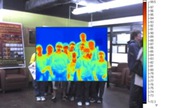Highlight
IGERT Trainees Help to Educate and Inspire Others
Achievement/Results
For the fourth straight year, trainees and affiliates of the National Science Foundation’s (NSF) Integrative Graduate Education and Research Traineeship (IGERT) program in Indoor Environmental Science and Engineering at The University of Texas (UT) have been actively involved in a wide range of public outreach efforts. These activities provide a service to the community, but also allow our students to hone their public communication skills and to work as interdisciplinary teams on public outreach projects. In total, our IGERT students logged over 600 student-hours of community service over the past year. Examples include indoor air demonstration projects at Explore UT, an annual public open house on the UT campus, Minority Introduction to Engineering (MITE) Science camp, and the Women in Engineering Program. Our students judge science projects at an elementary school, are working with a middle school to develop an indoor air management plan, and helped a non-profit (Children’s Environmental Health Institute) to develop criteria for ranking and educating hotels in terms of reducing children’s exposure to toxic contaminants.
Seven IGERT trainees and affiliates from three different academic departments completed demonstrations at Explore UT. These demonstrations included application of the House of Pressure, a scaled-down plastic house that can be used to demonstrate air flow patterns and pollutant sources and transport in homes. This year was the first in which IGERT trainees and affiliates were able to employ an infrared imaging system to demonstrate to attendees heat loss from their bodies and buoyant plumes that affect air flow around their breathing zones and room. Several other demonstrations were performed, including the rapid formation of secondary organic nanoparticles from ozone reactions with common terpenoids in consumer products. An estimated 300 people attended the IGERT demonstrations at Explore UT over a six hour period.
In collaboration with lectures delivered by IGERT faculty participant Richard Corsi, several trainees completed demonstrations similar to those described above as part of the Minority Introduction to Engineering summer science camp involving 100 minority high school students who are considering attendance of college in an engineering discipline. Similarly, IGERT faculty participant Jeffrey Siegel worked with trainees Brent Stephens and Priscilla Guerrero to provide lectures and demonstrations to young high school women as part of the UT Women in Engineering Program. New IGERT faculty participant Ying Xu also delivered a lecture on human exposure to phthalates to the Center for Women and Gender Studies.
Eighteen IGERT trainees and affiliates formed four interdisciplianry groups to assist the Children’s Environmental Health Institute (CEHI) with background information related to exposure of children to toxic chemicals in hotel chains. Specifically, IGERT students did an intensive search of existing literature and developed background information related to major risks of contaminant exposure and how such exposures can be reduced. The CEHI is now using this information to develop a survey of hotel chains or individual hotels that wish to be considered for certification akin to LEED® ratings for buildings.
Finally, trainee Brent Stephens joined IGERT faculty participant Kerry Kinney to deliver back-to-back lectures to the public on “Energy and Indoor Air Quality: Implications of HVAC Filtration.” Their joint seminar was invited and sponsored by the Austin Energy Green Building program.
Address Goals
The aforementioned outreach activities go to the heart of learning, not just for the public that receives information from our IGERT students, but also for our IGERT students themselves. Students need to “boil down” complex subjects in such a way that the general public can understand those concepts. In doing so, our IGERT students employ state-of-the-art demonstrations of pollutant emissions, air flow in buildings, and the effects of human beings on indoor air flow through analysis of buoyant plumes. They also assist not-for-profit organizations such as the Children’s Environmental Health Institute and help to inspire bright young minds such as those high school students who participate in the Minority Introduction to Engineering and Women in Engineering programs.






